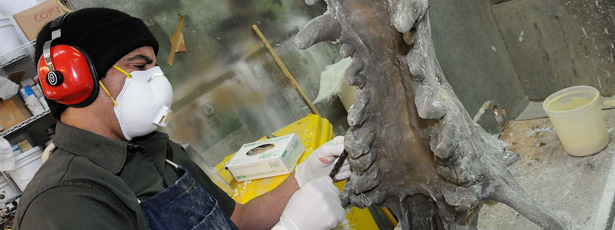Health & Safety
As with most jobs, it’s important that preparators should be well versed in the health and safety hazards that they might encounter in their work both in the field and in the lab setting where they spend much of their time.
Most preparators work their entire career without major injury, and they do so by following safety rules, accurately assessing the safety and health needs of a task, and mitigating those risks using a number of commonsense steps:
- Substitution — Consider whether it’s possible to reduce the risk of a process by using a less hazardous alternative, for example, using an alternative chemical that has less health risks.
- Environmental or engineering controls —These controls include fume hoods and dust extractors, safety guards on tools, stops on adjustable tables, etc. These are designed to protect you and others while working.
- Personal Protective Equipment (PPE) — PPE is required for some tasks and recommended for others. PPE includes hearing protection (earplugs or earmuffs), gloves (nitrile, latex, leather), respirators (disposable dust masks or respirators), eyewear (safety glasses or goggles), clothing (Tyvek, or leather aprons, coveralls or jackets).
- Behavioral safety — Behavioral safety includes following appropriate practices, reminding others to use them, and reporting reckless behavior to the appropriate person; as well as situational awareness, which ensures that if safety needs change during the task, the worker stop and reassess the safety practice and will adapt his/her methods as needed.
Laboratory health and safety is governed by a wide variety of regulations at the federal, state, and local level. If you work for a museum or university, there will almost certainly be institutional rules on health and safety issue. It’s important to be aware of these and this site can provide only a brief outline of some of the things to keep in mind. Fortunately, there is extensive information available online about general lab safety and most institutions have health and safety personnel who should be able you to assist in accessing the resources you need to provide a safe work environment.
Hazards
Hazards encountered in the lab hazards may arise from the collections themselves or from the work involved in preparing them. These include:
- Dust
- Chemicals and solvents
- Tools and equipment
- Naturally-occurring radiation
- General issues. (e.g. allergies, ergonomics)
- Safety hazards in the field include travel to and from sites; working in rough terrain and backcounty; and risks associated with excavating and moving heavy objects.
Additional Health & Safety Resources
Several talks at the April 2008 Fossil Preparation and Collections Symposium held at the Petrified Forest National Park also contain useful Health and Safety information. Abstracts are available online:
• The Preparator: A Survival Guide – by Scott Madsen
• A Paleontology Laboratory Approach to Radon Hazards, Detection and Mitigation – by Gavin McCullough
• ACTS is a not-for-profit corporation that provides health, safety, industrial hygiene, technical services, and safety publications to the arts, crafts, museums, and theater communities. It also provides a worldwide free information service by phone, mail, and e-mail providing: professional safety and industrial hygiene advice; copies of educational materials; referrals to doctors and other and sources of help without cost.
• Howie, Frank M. 1992. The Care and Conservation of Geological Material: Minerals, Rocks, Meteorites, and Lunar Finds. Boston: Butterworth-Heinemann.


